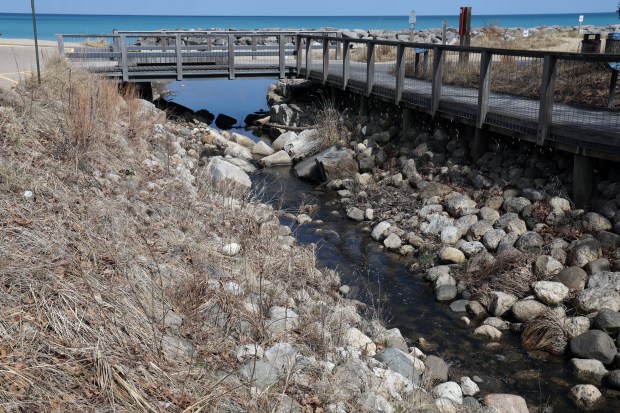The sun beat down as Liz Ricketts peered over a wooden bridge on Rosewood Beach in Highland Park. Below her, a narrow stream carved through the sand, flowing from a grove of barren trees into Lake Michigan.
Through the murky water, littered with leaves, she spotted two rainbow trout lingering along the riverbed. They faced upstream, swimming through jagged rocks and a gentle current.
She scribbled her observations of the familiar scene on a folded slip of paper. But it wasn’t trout she was looking for — it was suckers.
“I don’t see any in here right now,” Ricketts said, scanning the stream with polarized glasses. “Basically, you count the suckers you see, to the best of your ability.”
Ricketts, a natural areas manager with the city’s Park District, documents white suckers for a Shedd Aquarium study tracking the species’ migratory patterns. Volunteers have monitored 17 sites along lakes Michigan and Superior for eight years.
But this year, the suckers came weeks early. An unusually warm winter left the Great Lakes with virtually no ice cover, accelerating the seasonal warming of the waters. It may have served as an early indicator for the species to begin its annual traverse upstream.
The slight change in suckers’ migratory patterns could have a sweeping impact on an already fragile ecosystem.
“There’s a real rhythm in nature,” said Karen Murchie, the Shedd Aquarium scientist who leads the project. “It could start getting thrown off.”
It’s just one cascading effect of the waning ice cover across the lakes, a product of climate change.
With little research, experts are still unsure of the precise impact. But it could set off a chain of events harming fish populations, eroding beaches and increasing toxic blue-green algae blooms.
The National Oceanic and Atmospheric Administration began imaging the Great Lakes’ ice cover in 1973. Since then, the amount of ice has steadily fallen, aside from some seasonal fluctuations.
Typically, the ice coverage across the lakes peaks at an average of 53% in late February or early March. This year, the maximum ice cover was just 16% in the third week of January. It then plummeted to a historic low of 2.7% in early February, according to NOAA. Average ice cover from Jan. 1 through March 17 was 5%, breaking the previous record low of 5.5% for this time period set in 2012.
Meanwhile, the world experienced record heat in January for the eighth-straight month. Chicago’s February was one of the hottest in the city’s history.
“Ice cover is a defining feature of the lakes,” said Aaron Packman, a civil and environmental engineering professor at Northwestern University and the director of the university’s Center for Water Research. “This is a dramatic change in winter season conditions.”
The food chain
Without ice, the Great Lakes absorb sunlight faster, which drives surface warming. NOAA has already predicted that lake surface temperatures will increase 7 degrees by 2050 due to climate change.
For suckers, warmer water acts as a cue to begin spawning runs. As they journey through tributaries, they transport nutrients — their eggs and waste enrich the food web. If migratory fish appear early, it may alter the rest of the ecosystem.
“The suckers show up sooner, but the rest of the food web may not be really ready to take on those nutrients,” said Murchie, who also works as the Shedd’s director of freshwater research. “We don’t know for sure, but we want to keep an eye on it.”
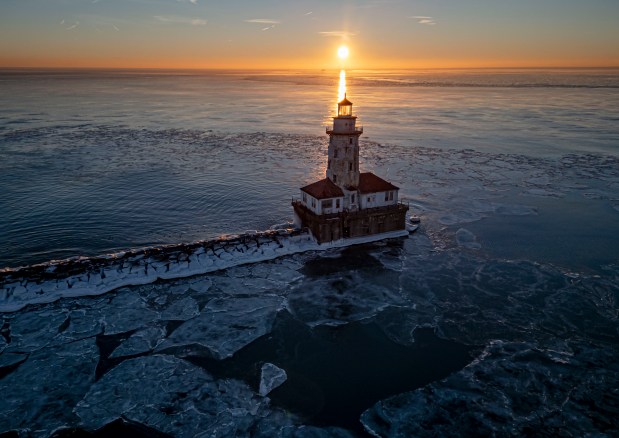
There are other ways a lack of ice could indirectly affect fish. Accelerated surface warming can lead to increased thermal stratification — a process in which colder, denser water settles at the bottom lake. The deepest layer can then lose dissolved oxygen, killing plankton and other organisms.
This can cause a ripple effect across the food chain, resulting in a loss of biodiversity, scientists say.
“What we’re seeing is there’s less chance for that stratified layer to break down, because the temperature gradient between the top and bottom is that much stronger than we’ve had in the past,” said Alan Steinman, a research professor at Grand Valley State University’s water resource institute. “The chances of the bottom layers going anoxic, where there’s no dissolved oxygen at all, is much more likely.”
Fishermen in the greater Chicago area who spoke with the Tribune said they have yet to see an impact on Lake Michigan’s fish populations.
But that doesn’t mean they won’t in the future, according to Steinman.
“The lake is experiencing considerable pressure and is certainly operating in a different way than even 20 years ago,” he said.
Toxic blue-green algae blooms
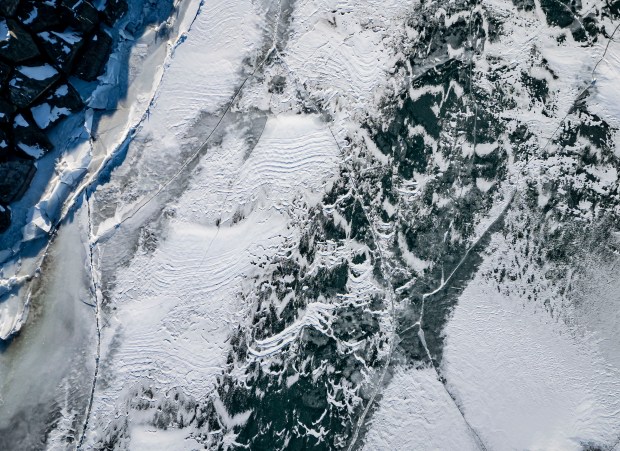
Deep below the surface, lake stratification has other effects. Anoxic water releases sedimented phosphorus at the bottom of the lake. Phosphorus fuels toxic blue-green algae blooms.
It’s unlikely that Chicagoans will see blooms pooling on Lake Michigan’s surface, according to Steinman. Trillions of invasive quagga mussels blanket the lakebed, filtering through the water and decreasing phosphorus.
But in shallow Lake Erie, blue-green algae blooms are increasing, according to NOAA. Erie is more susceptible to warming because of its depth.
The toxins can harm humans and animals if ingested, taint coastlines and affect businesses dependent on the lake.
“These blue-green algae blooms aesthetically, you know, are terrible. So there’s an economic cost associated with that,” Steinman said.
Habitats
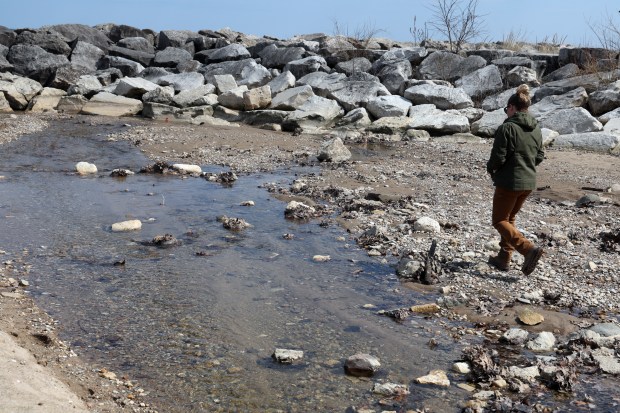
Meanwhile, in northwest Lake Superior sits the rugged, isolated Isle Royale. There, scientists have conducted one of the longest continuous predator-prey studies in the world, observing the interplay of moose and wolves since 1958.
But this year, several days of above-freezing temperatures left only a fine sheet of ice over the waters. Researchers were forced to depart weeks early to make sure their ski-plane could take off.
“It was very disappointing to not be able to continue the work,” said Sarah Hoy, co-leader of the project and a research professor at Michigan Technological University. “It’s really unprecedented.”
The ice itself forms part of the ecosystem. Wolves often rely on the ice cover, which is less taxing to navigate than uneven terrain, to move across the island.
“The ice makes a path of least resistance for wolves, so they do use those habitats,” Hoy said.
Elsewhere, the ice provides a sanctuary for different organisms. Ice algae, which help form the critical foundations of the food web, cling to the base of the ice cover. Whitefish, which are highly valued for commercial fishing, rely on ice as a protective buffer in spawning areas, scientists say.
In shallow areas, where whitefish scatter their eggs, the ice dampens wave action. A lack of ice could potentially affect their ability to reproduce.
“It could mean low recruitment, meaning a lot less whitefish entering into the population because they weren’t able to survive,” Murchie said.
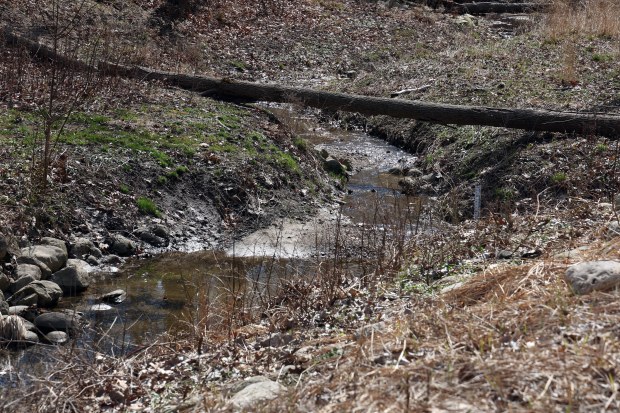
The surging waves could also wreak havoc on beaches and bluffs, eroding the shore and even increasing flooding. Chicago is battling erosion and unpredictable lake levels on its 26 miles of public shoreline
.According to a 2021 study, between 2012 and 2019 the Chicago shoreline lost an average of nearly half the parts of its beaches that were not submerged. In January 2020, severe storms and high lake levels created one of the biggest threats to Chicago beaches in years, causing an estimated $37 million in damages.
“Ice essentially dampens high waves,” said Ayumi Fujisaki-Manome, an associate research scientist at the Cooperative Institute for Great Lakes Research at the University of Michigan, a collaboration with NOAA. “If you lose that ice protection, the shoreline will be exposed to high waves, so that in that sense, it’s true that loss of ice cover will lead to coastal erosion.”
What’s needed now, scientists say, is more research. Only when the ice cover is fully understood can solutions be implemented, scientists say.
“We probably need more investment to understand the net impact,” Fujisaki-Manome said.
Back at Rosewood Beach, Ricketts surveyed her surroundings: the gentle stream, the clear blue lake and a mound of granite slabs encircling the beach. The rocks were part of a 2015 renovation project aimed at reducing erosion on the lake bluffs.
“This is like a significant, unique ecosystem, which is threatened by wave action,” Ricketts said. “And without those ice formations, which are protecting the soil on our slopes, they are vulnerable.”
So many of the beach’s looming threats seemed to tie back to ice, she said. Changing migratory patterns, erosion, unpredictable water levels.
Often, she’s struck by the seeming inevitability of it all. “You can kind of get back in a mind space of like, ‘Are we doing enough?’” Ricketts said. “I don’t know.”


